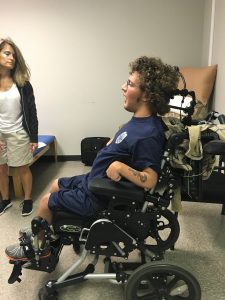Modular Dynamic Seating Components Vs. Integrated Dynamic Seating Systems
Updated 9/26/22
Our last two blogs have addressed Integrated and Modular Dynamic Seating. Integrated systems are a dedicated mobility base incorporating several areas of movement. Modular components can be retrofitted to a new or existing mobility base and used individually or in combination with one another.
Let’s take a look at Spencer’s transition from an Integrated system to Modular components.
Spencer’s Dynamic Wheelchair Story
Spencer is a young man who has used an Integrated Dynamic System for a number of years. He has increased muscle tone and frequently extends with significant force. Before receiving the Integrated Dynamic System, he had broken numerous components on his seating system and manual wheelchair.
The Integrated Dynamic System prevented breakage of areas that were problematic in the past, such as headrest and backrest mounting hardware.
However, Spencer did break some of the Dynamic Seating components, such as the dynamic footboard.
He also created significant “wear and tear” of the springs on the system which required frequent replacement. In fact, his Dad kept some of these spare parts on hand and had learned how to replace certain items.
Despite these issues, Spencer could readily move the dynamic components, his overall extensor tone was decreased, and he preferred this system over his previous static wheelchair. You can see Spencer at rest and activating the dynamic components in the photos below.
Seating Dynamics Modular Dynamic Components
The Integrated Dynamic System Spencer had been using was being discontinued and his family was quite concerned that they would no longer be able to get replacement parts.
As a result, we explored other options and chose a standard manual tilt in space wheelchair with Seating Dynamics Modular Dynamic components, specifically a Dynamic Rocker Back and Dynamic Footrests.
One thing the family noticed immediately was how quiet the new components were! The previous Integrated system squeaked throughout the day due to the movement of the springs.
Another advantage for Spencer is that each Dynamic Footrest responds individually. This has resulted in much more lower extremity movement, as these respond to Spencer’s tone increases more readily than the one piece footboard he had before. In fact, so much of his force is diffused at the footrests, that he is showing less movement at the dynamic back.
This new modular approach is working very well for Spencer and his family.



I have known Spencer since he was a young child. He is a wonderful young man with a very supportive family. Once a client becomes accustomed to using dynamic seating, losing that feature impacts function, sitting tolerance, and more. I’m so glad he can continue to benefit from dynamic seating.
What are your dynamic seating experiences?